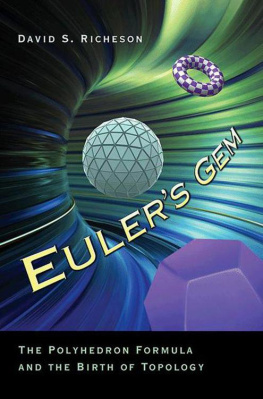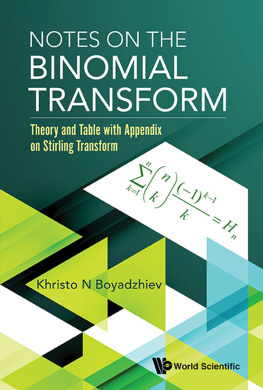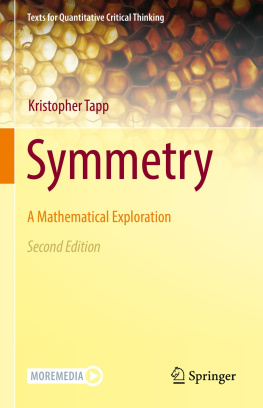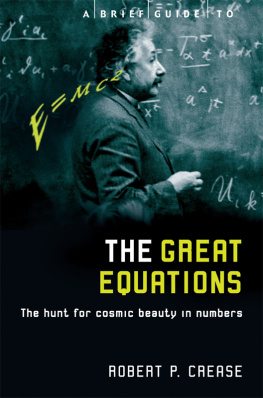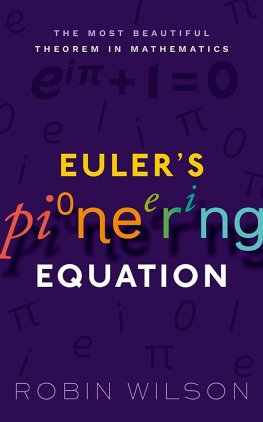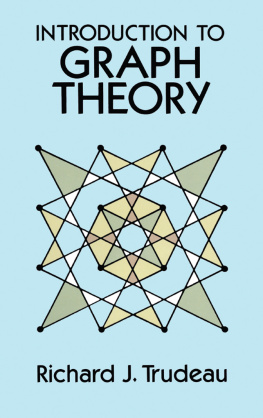EULERS GEM
EULERS GEM
THE POLYHEDRON FORMULA
AND THE BIRTH OF TOPOLOGY
DAVID S. RICHESON

Copyright 2008 by Princeton University Press
Published by Princeton University Press, 41 William Street,
Princeton, New Jersey 08540
In the United Kingdom: Princeton University Press, 6 Oxford Street, Woodstock,
Oxfordshire OX20, 1TW
All Rights Reserved
Library of Congress Cataloging-in-Publication Data
Richeson, David S.
Eulers gem : the polyhedron formula and the birth of topology / David S. Richeson.
p. cm.
Includes bibliographical references and index.
ISBN-13: 978-0-691-12677-7 (alk. paper)
ISBN-10: 0-691-12677-1 (alk. paper)
1. TopologyHistory. 2. Polyhedra. I. Title.
QA611.A3R53 2008
514.09dc22 2008062108
British Library Cataloging-in-Publication Data is available
This book has been composed in Aldus
Printed on acid-free paper.
press.princeton.edu
Printed in the United States of America
10 9 8 7 6 5 4 3 2 1
To Ben and Nora
your faces
all your edges
I love you from vertex to toe
CONTENTS
PREFACE
A mathematician is a device for turning coffee into theorems.
Alfrd Rnyi, oft repeated by Paul Erds
In the spring of my senior year of college I told an acquaintance that I would be pursuing a PhD in mathematics in the fall. He asked me, What will you do in graduate school, study really big numbers or calculate more digits of pi?
It is my experience that the general public has little idea what mathematics is and certainly has no conception what a research mathematician studies. They are shocked to discover that new mathematics is still being created. They think that mathematics is only the study of numbers or that it is a string of courses that terminates at calculus.
The truth is, I have never been that interested in numbers. Mental arithmetic is not my strong point. I can split a dinner check and calculate a tip at a restaurant without reaching for a calculator, but it takes me about as long as it does anyone else. And calculus was my least favorite mathematics class in college.
I enjoy looking for patternsthe more visual the betterand untwisting intricate logical arguments. The shelves in my office are full of books of puzzles and brain teasers with my childhood pencil marks in the margins. Move three matchsticks to form this other pattern, find a path through this grid that satisfies this list of rules, cut up this shape and rearrange it to be square, add three lines to this picture to create nine triangles, and other mind-benders. To me, this is mathematics.
Because of my love of spatial, visual, and logical puzzles, I have always been attracted to geometry. But in my senior year of college I discovered the fascinating field of topology, generally understood to be the study of nonrigid shapes. The combination of beautiful abstract theory and concrete spatial manipulations fit my mathematical tendencies perfectly. The loose and flexible topological view of the world felt very comfortable. Geometry seemed straight laced and conservative in comparison. If geometry is dressed in a suit coat, topology dons jeans and a T-shirt.
This book is a history and celebration of topology. The story begins with its prehistorythe geometry of the Greek and Renaissance mathematicians and their study of polyhedra. It continues through the eighteenth and nineteenth centuries as scholars tried to come to grips with the idea of shape and how to classify objects without the rigid conditions imposed by geometry. The story culminates in the modern field of topology, which was developed in the early years of the twentieth century.
As students, we learned mathematics from textbooks. In textbooks, mathematics is presented in a rigorous and logical way: definition, theorem, proof, example. But it is not discovered that way. It took many years for a mathematical subject to be understood well enough that a cohesive textbook could be written. Mathematics is created through slow, incremental progress, large leaps, missteps, corrections, and connections. This book shows the exciting process of mathematical discovery in actionbrilliant minds thinking about, questioning, refining, pushing, and altering the work of their predecessors.
Rather than giving a simple history of topology, I chose Eulers polyhedron formula as a tour guide. Discovered in 1750, Eulers formula marks the beginning of the transition period from geometry to topology. The book follows Eulers formula as it evolved from a curiosity into a deep and useful theorem.
Eulers formula is an ideal tour guide because it has access to marvelous rooms that are rarely seen by other visitors. By following Eulers formula we see some of the most intriguing areas of mathematicsgeometry, combinatorics, graph theory, knot theory, differential geometry, dynamical systems, and topology. These are beautiful subjects that a typical student, even an undergraduate mathematics major, may never encounter.
Also, on this tour I have the pleasure of introducing the reader to some of historys greatest mathematicians: Pythagoras, Euclid, Kepler, Descartes, Euler, Cauchy, Gauss, Riemann, Poincar, and many othersall of whom made important contributions to this subject and to mathematics in general.
This book has no formal prerequisites. The mathematics that a student learns in a typical high school mathematics sequencealgebra, trigonometry, geometryis sufficient, but most of it is irrelevant to this discussion. The book is self-contained, so in the rare cases that I need to, I will remind the reader of facts from these mathematics courses.
Do not be misled, thoughsome of the ideas are quite sophisticated, abstract, and challenging to visualize. The reader should be willing to read through logical arguments and to think abstractly. Reading mathematics is not like reading a novel. The reader should be prepared to stop and ponder each sentence on its own, reread an argument, try to come up with other examples, carefully examine the figures in the text, search for the big picture, and use the index to look back at the exact meaning of technical terminology.
Of course, there is no homework and no final exam at the end of the book. There is no shame in skipping over the difficult parts. If a particularly thorny argument is too difficult to grasp, jump to the next topic. Doing so will not sabotage the rest of the book. The reader may want to fold over the corner of a challenging page and come back to it later.
It is my belief that the audience for this book is self-selecting. Anyone who wants to read it should be able to read it. The book is not for everyone, but those who would not understand and appreciate the mathematics are precisely those who would never pick it up in the first place.
I had the precious advantage that I was not writing a textbook. I made every effort to be honest and rigorous in my descriptions of the mathematics, but I had the liberty to gloss over pesky details that confuse more than they illuminate. This way I could write at a higher level and focus on ideas, intuition, and the big picture. By necessity I was only able to give a superficial treatment of the many fascinating ideas in this book. Anyone interested in reading more about these topics or in seeing how the missing details complete the picture should consult the list of suggested readings in .
While this book is accessible to a broad audience, I also wrote it for mathematicians. Although parts of this book overlap with other books, there is no single resource that contains all this information. There is an extensive bibliography at the end of the book that includes many of the original papers. It should aid scholars who would like to dig deeper into the subject matter.
Next page
